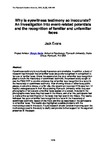Why is eyewitness testimony so inaccurate? An investigation into event-related potentials and the recognition of familiar and unfamiliar faces
| dc.contributor.author | Evans, J. | |
| dc.date.accessioned | 2019-05-17T11:09:41Z | |
| dc.date.available | 2019-05-17T11:09:41Z | |
| dc.date.issued | 2015 | |
| dc.identifier.citation |
Evans, J. (2015) 'Why is eyewitness testimony so inaccurate? An investigation into event-related potentials and the recognition of familiar and unfamiliar faces', The Plymouth Student Scientist, 8(2), p. 133-148. | en_US |
| dc.identifier.issn | 1754-2383 | |
| dc.identifier.uri | http://hdl.handle.net/10026.1/14100 | |
| dc.description.abstract |
Eyewitness-testimony is notoriously inaccurate and unreliable. In addition, a body of research has indicated that unfamiliar faces are poorly recognised in comparison to famous or familiar faces. Under the assumption that poor unfamiliar face recognition plays a role in the inaccuracy of eyewitness testimony, the present study sought to use the P300 ERP to provide evidence that unfamiliar face recognition is a factor in the inaccuracy of eyewitness testimony. After showing videos of either busy public places, mock-crime videos, or a film clip, this experiment recorded EEG data from 12 healthy undergraduates in their 20s attending Plymouth University whilst they saw photographs of famous and unfamiliar faces appear on a screen. Included in the photographs were faces they had seen in the videos, and after this, participants had to make a line-up identification of the faces they had seen in the videos. The results indicated that poor unfamiliar face recognition is a factor in the inaccuracy of eyewitness testimony, based on the P300 and line-up responses of the participants to unfamiliar faces. The results also highlighted possible problems with the methodology used in this study. Future research should consider improving upon the methodology used in this study to clarify and provide further support for the argument presented in this paper. | en_US |
| dc.language.iso | en | en_US |
| dc.publisher | University of Plymouth | |
| dc.rights | Attribution 3.0 United States | * |
| dc.rights.uri | http://creativecommons.org/licenses/by/3.0/us/ | * |
| dc.subject | famous or familiar faces | en_US |
| dc.subject | eyewitness-testimony | en_US |
| dc.subject | unfamiliar faces | en_US |
| dc.subject | facial recognition | en_US |
| dc.title | Why is eyewitness testimony so inaccurate? An investigation into event-related potentials and the recognition of familiar and unfamiliar faces | en_US |
| dc.type | Article | |
| plymouth.issue | 2 | |
| plymouth.volume | 8 | |
| plymouth.journal | The Plymouth Student Scientist |



